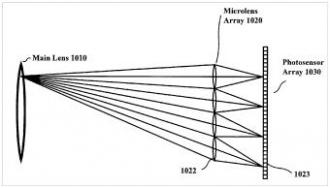Patenting inventions – the Lytro example
Posted Thursday, March 08, 2012.
A new kind of camera has recently attracted some press, and it contains some interesting features. The Lytro (www.lytro.com) camera has adopted something called Light Field technology, which allows you to refocus a photograph after you have taken it.
So how is “Light Field” innovative? And how has the young company Lytro protected its innovation? A brief look at the company website and the patent literature answer both questions.
CEO Ren Ng adopts an old technique of obtaining a large number of images from the subject, each image coming from a slightly different angle. Each image is recorded on a photo-sensor array.
The Lytro camera innovates by capturing and storing the sub-images, and then later allowing the user to reassemble the sub-images into a “virtual image” having a “virtual focus.” All of this can be done within the camera itself.
Fig. 10, U.S. Patent 7,936,392
U.S. Patent 7,936,392, with Ren Ng named as an inventor, protects the method and apparatus for constructing this “virtual image” of a scene. Several patent applications have also been filed for different aspects of the product.
The Lytro story is an excellent example of the tradeoffs inherent in the patent system. The Ng patents and applications teach the world how to create these images. In exchange, the patent holder gains some time-limited rights in his invention. This inventor gets some breathing room to compete, and/or creates value in the business for the purpose of attracting additional investment.
Right out of the Gate, America Invents Act
Posted Wednesday, February 29, 2012.
Big changes are in store for patent seekers. These changes present new (and more difficult) challenges to inventors, especially smaller innovators.
The Leahy-Smith America Invents Act (AIA) is now law, and goes into effect on September 16, 2011. Inventors have just six months left to consider changing their strategies towards patenting their ideas. One aspect of the AIA in particular could surprise the unwary inventor.
For many decades, the U.S. was essentially the only country to follow a first-to-invent patent philosophy. First-to-invent means that the first inventor is entitled to the patent, even if another gets to the patent office first with the idea. This philosophy played well to the smaller inventor, who may not have the time or means to invest in the patent application process until it is clear to him that the idea has economic value. On the other hand, inventors with more resources could also follow this same strategy to conserve resources for only those ideas that ultimately show promise.
Under the AIA, though, the U.S. is aligning its patent philosophy to the rest of the world. The “first-inventor-to-file” philosophy gives the first application, not the first inventor, the right to patent the invention. Essentially, this means that inventors no longer have much time to evaluate whether a patentable idea is valuable for fear of another filing earlier for the same idea. Inventors with resources can adapt simply by filing their patent applications earlier and then simply abandon those that do not prove out economically.
But small inventors now are faced with a more difficult path: steer scarce resources to potentially worthless IP, or risk being frozen out of the idea by another’s patent?
Invent!
Posted Friday, February 10, 2012.
This blog is dedicated to inventors and innovators working throughout the Pacific Northwest. I promise to keep things interesting across a number of topics: I’ll relate clever and interesting ideas old and new. Legal disputes that highlight aspects of intellectual property protection. Statistics on the state of inventiveness in our region. And periodic reports on the ever-shifting law in intellectual property. I hope (and I hope that you tell me) that these posts spur your interest. Happy reading!
‹‹ Newer Entries | 1 | 2



